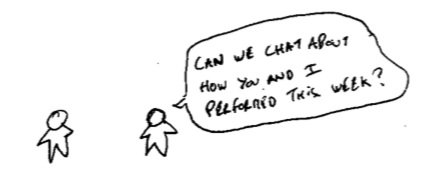 Sharing constructive feedback gives you this ability to guide your team members and help them learn and grow.
Sharing constructive feedback gives you this ability to guide your team members and help them learn and grow.
Unfortunately, we never learn how to give feedback. We assume that it is intuitive; and that you should naturally master this skill.
But in practice, giving feedback feels uncomfortable.
We even often avoid doing it…
[In these reflections, I focus on “individual feedback” given to a team member (e.g. superior, peer, or subordinate). This excludes traditional employee review, team performance check-in, and managing yourself with feedback analysis.]
Feedback is an undervalued tool.
“Important achievements require a clear focus, all-out effort, and a bottomless trunk full of strategies. Plus allies in learning.”
– Carol Dweck, Mindset
Let me emphasise a key part of what Carol Dweck wrote here: “Plus allies in learning.” This is by giving useful feedback to your team (employee, peer, boss…) that you can make a real difference in their personal development.
In these reflections, I tackle three main mistakes:
- No feedback;
- Vague feedback;
- Not focusing on improvement.
My goal here?
To give you the tools to be more comfortable giving useful feedback to any members of your team.
Mindset: How to approach sharing feedback
If you want to be able to give great feedback, you need to be aligned on the purpose of feedback.
So what is it?
The purpose of feedback is “to improve“. The Oxford dictionary defines it well:
“Information about reactions to a product, a person’s performance of a task, etc. which is used as a basis for improvement.”
Feedback differs from:
- condemnation (punishing someone for having done something wrong) and
- criticism (saying that something is bad).
“Any fool can criticize, complain, and condemn—and most fools do. But it takes character and self-control to be understanding and forgiving.”
― Dale Carnegie, How to Win Friends and Influence People
The goal of giving feedback is to seek improvements.

We say, “giving feedback” for a reason
As a team leader, you should consider feedback as a gift to their recipients. It aims at helping your team members grow and get better at what they do.
Giving feedback benefits three groups:
- The recipient, as it focuses on helping them grow and deliver great work;
- The team, as a better team member increases the overall performance of the team;
- You, the team leader, as it’s your role to increase the value of what each team member and your team, as a group, can deliver.
Having this in mind, you can agree that the worst feedback is no feedback. It doesn’t help anyone. Unfortunately, it’s an easy way out that many people take, since giving feedback often feels uncomfortable.
So it’s your role as a good team player to help your team members grow and create more value for them and the team as a whole.
Positive feedback vs. Negative feedback
There’s a debate about positive vs. negative feedback.
Praising is important. Positive feedback tells someone that they did something well. And it encourages them to continue. It’s motivating.
“A sincere compliment is one of the most effective tools to teach and motivate others.”
— Zig Ziglar
But giving negative feedback also matters. It helps someone understand what they could have done better, and define how they can improve. It’s empowering.
“Criticism is dangerous, because it wounds a person’s precious pride, hurts his sense of importance and arouses resentment.”
― Dale Carnegie, How to Win Friends and Influence People
Negative feedback is very different from empty criticism, which has no positive purpose.

Both types of feedback are important
Though I like to praise my team members when they do well, I consider that negative feedback can be even more helpful than positive feedback.
That’s the recipe I apply to myself when I do my own feedback analysis.
But be careful:
Being constantly reminded of how you could be performing better can feel overwhelming and demotivating…
As a team leader, you should find the right balance between encouraging your team and helping them spot opportunities to grow.
What’s constructive feedback?
Simplified to the maximum, constructive feedback is “GUSI”.
That means:
1. Genuine. There’s no point to hide the reality. Don’t ignore the elephant in the room. It doesn’t help anyone. If there’s something clearly wrong, just communicate it to your team member. Be honest about that.
2. Useful. Obviously, your feedback has to be useful. It must help the recipient understands what’s wrong, and how to course correct this.
3. Specific. Giving clear examples will really help the recipient identify what is wrong. Make it fact-based, as much as you can.
4. Immediate. The frequency of your feedback makes a real difference. Every week or two weeks, I try to meet one-to-one with my team members and share my feedback. The chat can be as quick as a 10-minute session (longer if necessary).
So be honest. Aim at helping. Give examples. And do this frequently.
Before: 5 steps to prepare yourself to give feedback
You have to be prepared before you can give constructive feedback.
1. Observe carefully.
Observing is the key to being specific and useful.
You need to pay attention to your team members, their work, and their challenges.
2. Suspend immediate judgement.
When something negative happened, try to understand the context. It’s important to acknowledge the issues the person had to face and the effort they put into doing their work.
Try to understand why they did what they did.
3. Pick the most important points.
Every “battle” is not worth fighting. Avoid overwhelming your team members with tons of feedback. Just focus on the feedback that really matters.
And remember that feedback is about behaviour, not personality.

4. Create themes.
This is another trick to be more specific and avoid being overwhelming. It is actually easier to receive feedback when they are grouped in themes.
You first share the theme (e.g. public speaking) and you illustrate with specific examples (e.g. Tuesday’s presentation).

5. Identify paths to growth.
Before sharing your feedback, get some ideas of how the person could improve. This is actually the most important part of giving feedback.
Here’s what a friend told me:
“The worst is when you get feedback and no suggestions on how to improve. I’ve had that before. Bloody pain.”
You see how important this can be.
Depending on the situation, you can either encourage the recipient to come up with ideas first and guide them. Or you can share immediately what would be the best way for the person to grow.
What else?
Here’s a framework I find useful when I prepare myself to give feedback:
When you give feedback to someone, you actually comment on either of two things:
1. The what: the content of their work;
2. The how: their way of working, being, and communicating.
So when you’re creating themes, ask yourself if are you addressing the what or the how.
During: When and how to give constructive feedback
The first few times you share your feedback, you may feel a little bit out of your comfort zone. With practice, it becomes more intuitive.
My suggestion is to keep it informal and human.
Actually, one mistake is to make it feel like a review or a trial. That happens when you make it too formal.
(The only reason to keep this process formal is when something really bad happened. But that’s almost when we jump from giving feedback to managing a crisis.)

What should a feedback “session” look like?
As I give feedback every week (or two), I often do that in a 10-minute chat.
We grab some tea or coffee and chat about how we feel about the work we’ve done. If I’m travelling with my team, I take a cab ride or a flight as perfect excuses to take a step back on our work and share feedback.
I also always make sure to ask for feedback too.
First, it’s essential for you. Second, it makes your team members feel that it’s a two-way process. You’re not being patronising since both of you are working on helping each other become better.
Depending on the rhythm in your workflow, you can schedule regular catch ups. It can help.

Keep this in mind with new team members
If it’s the first time you give feedback to a new team member: explain the role of feedback.
Set the person in the right mindset. Make sure they understand that it’s not empty criticism, but constructive feedback that aims at getting better at what they do.